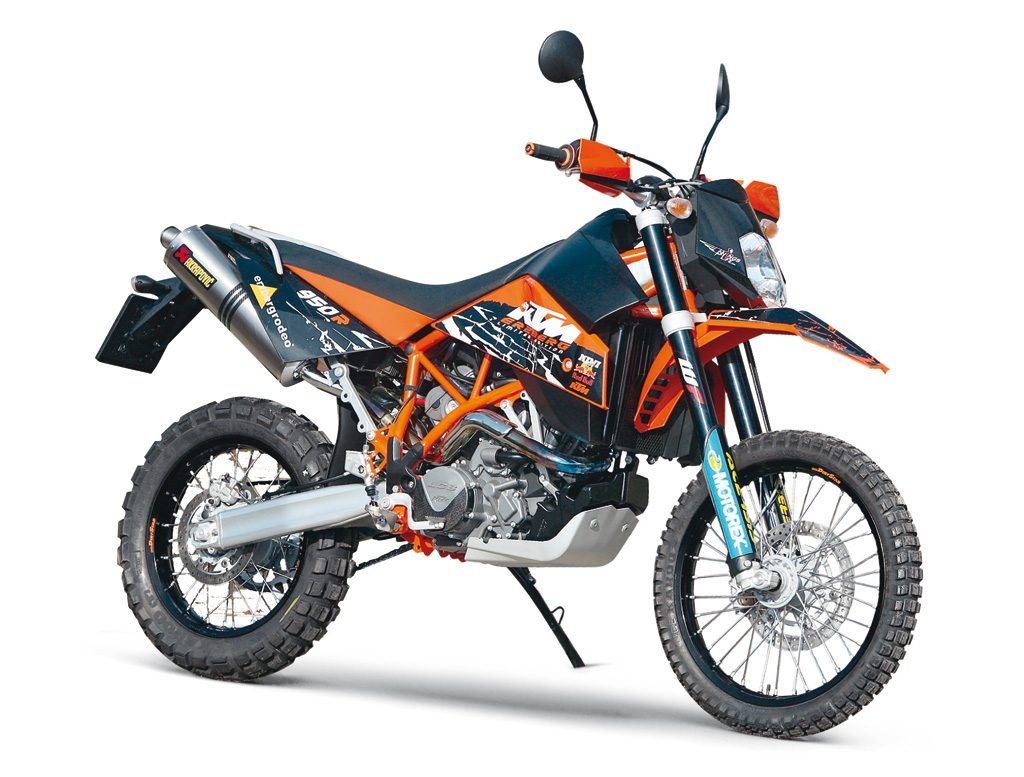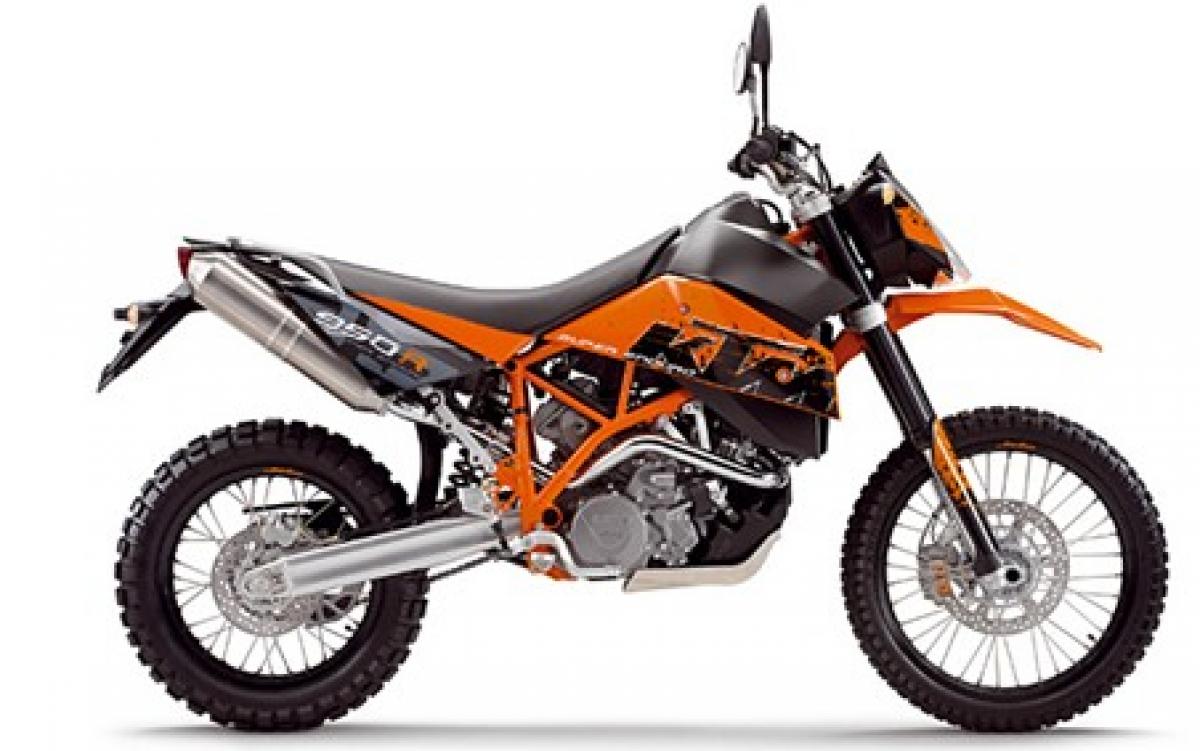Motorcycle Investor mag
Subscribe to our free email news

Future collectible - KTM 950 Super Enduro R

Dakar-derived demon
by Guy ‘Guido’ Allen, Jan 2021
Some motorcycles should come with a cape – this is one of them
Every now and then, you can’t help wondering if manufacturers like experimenting with their fans. The conversation goes something along the lines of, “Nah, they’ll never go for that!”
“I bet they will,” is the response, and before you know it the damn thing is rolling off the assembly line and being shuffled into showrooms. KTM’s utterly out-there 950 Super Duke R of 2006 to 2008 definitely falls into this category.
Essentially what the factory did was grab the LC8 powerplant that once graced the Dakar raid entries and then the 950 Adventure, and shoe-horn it into an enduro bike, albeit a very big one. Of course KTM wasn’t the only culprit at the time, as BMW did something similar with the HP2 Enduro 1200 boxer. Were the rival design teams sharing drugs, or having a friendly bet? We’ll never know.
The basic architecture of the Enduro was essentially a stripped-back Adventure, losing some 13 or so kilos in the process. The frame was a chromoly tube affair, sharing the Adventure’s substantial 1570mm wheelbase with WP Racing suspension either end. However the suspension spec was an area where the design differed significantly, with considerably more travel: 250mm up front and 255 on the rear. That front fork was 48mm spec in USD form, with a monoshock on the rear.
Braking was pretty conventional, with twin 300mm discs up front with two-spot calipers, with a 240mm disc and modest single spotter on the rear.
As for the centerpiece, the engine, the 75-degree V-twin was running carburettors (43mm Keihins) and claimed a very respectable 98 horses.
Given all that urge on tap, you’d think maybe KTM might be tempted to settle for a five-speed transmission. But no, it went the full six, reasoning the extra cog made sense for highway use.
When it came to fit-out, things were kept basic, with the minimum of instrumentation. Fuel capacity was a mere 13 litres to keep the package slim – very much in keeping with the enduro theme, but questionable when it came to practicality.
Then came the bad news, the price. Here it was launched at Au$19,800 plus on-road costs. So you’re talking substantially over $20k. That was a big ask for a manufacturer that was still in the early stages of developing a reputation for making litre-class machinery. In 2007, the retail price dropped $1800, bring the total to just under $20k on the road. Similar price drops happened overseas, as the company tried to move slow-selling stock.
Which is not to say the Super Enduro was a flop. Some 3000 units were built and, let’s face it, we’re talking about a very narrow niche in the market. Just how many people out there are willing to tackle an enduro bike of this stature?
In any case, the big twin made one hell of an impression when launched, though there was, naturally, some skepticism over the whole concept. It wasn’t just the giant engine and its big horsepower claim that raised eyebrows, but the lofty 920mm seat height had the potential to cause real problems for anyone under six feet (or 182cm) in height. And the weight of the thing – you’re talking near enough to 200 kilos rolling. That’s a sobering thought if the thing jumps on you in the scrub.
Experienced riders such as the talented Barry Ashenurst, who for years handled the dirt bike content for Motorcycle Trader magazine, expressed some doubts over the sheer size of the thing. At five foot ten (178cm) in height, he found the elevation of the seat a struggle.
He was less than whelmed with the highway performance of the machine. Unsurprisingly it had a tendency to wander at speed on the dirt-spec tyres and wasn’t really a pleasant touring experience. Still, what do you expect? Pukka adventure tourers are specced differently for a reason.
However he was more impressed with its dirt ability, where much of the substantial weight seemed to melt away. The proviso is of course that you’re still dealing with some basic laws of physics, where a lot of mass and a lot of speed will have consequences if you cock it up.
Those views have been backed up by others over the years. The general consensus is that handling one of these things takes a fair amount of riding talent and experience to get anywhere near the limits of its abilities.
Anyone who has played with these early KTM twins will know the 950 engine is in fact a delight and is generally long-lasting and robust. However some issues have popped up over the years for this model. Foremost is the location of the oil tank at the lower front of the engine. If you do take it off road and give it a whack, it can shift on its mounts and belt the radiator. Owners say the best solution is to replace the factory sump guard with a more substantial unit, from suppliers such as Black Dog.
Fuel pumps are also known to fail, and there are a variety of fixes. The final significant glitch is the rear subframe, which can crack. Welding in a little reinforcement seems to be the solution.
Of course owners have been keen to extend the stock fuel range. It seems the most popular fix is to fit a 30 litre bolt-on replacement tank from local maker Safari Tanks (safaritanks.com.au).
After all that, does the Super Enduro R seem like too much trouble? Not according to the owners. There is a very strong following for these things and they don’t seem to come on the market all that often.
Here’s the thing. If practicality was the priority in our toy-buying decisions, no-one would ever buy a Ferrari. And so it is with machines like the Super Enduro. A fair part of the fun is tied up in the bragging rights of having something lurking in the shed that has real teeth. Clearly, for some folk, the KTM fits that bill.

SPECS
KTM Super Enduro R (2006-2008)
ENGINE:
TYPE: Liquid-cooled, four-valves-per-cylinder, 75-degree V-twin
CAPACITY: 942cc
BORE & STROKE: 100 x 60mm
COMPRESSION RATIO: 11.5:1
FUEL SYSTEM: 43mm Keihin carburettors
TRANSMISSION:
TYPE: Six-speed, constant-mesh,
FINAL DRIVE: chain
CHASSIS & RUNNING GEAR:
FRAME TYPE: chromoly tube
FRONT SUSPENSION: WP Racing USD 48mm, 250mm travel
REAR SUSPENSION: WP Racing monoshock, 255mm travel
FRONT BRAKE: 300mm disc with twin-piston caliper
REAR BRAKE: 240mm disc with single-piston caliper
DIMENSIONS & CAPACITIES:
DRY WEIGHT: 185kg
SEAT HEIGHT: 820mm
WHEELBASE: 1570mm
FUEL CAPACITY: 13L
TYRES:
FRONT: 90/90-21
REAR: 140/80-18
PERFORMANCE:
POWER: 72kW @ 8500rpm
TORQUE: 95Nm @ 6500rpm
OTHER STUFF:
PRICE WHEN NEW: $19,800 plus ORC
GOOD
Fast
Powerful
Rarity
BAD
Too fast?
Ultra-tall seat
***

That engine
The history of KTM’s LC8 is said to go back as far as 1992, when a pair of engineering students cobbled together a twin out of two LC4 powerplants and took the result racing.
While the company spent some years shopping around for an off-the-shelf V-twin, it was eventually decided to develop one from scratch, in house. The company did however poach engineer Claus Holweg from Rotax to head up the project.
The end result had its first dyno run in August 1999.
More KTM: RC8 & RC8R
-------------------------------------------------
Produced by AllMoto abn 61 400 694 722
Privacy: we do not collect cookies or any other data.

Archives
Contact




